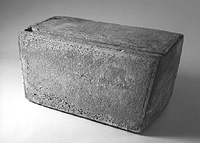An inscription in stone, written in a language and script of 2,000 years ago, has been found in Jerusalem that bears the words "James, son of Joseph, brother of Jesus."
If the inscription is authentic and refers to Jesus of Nazareth, it would be the earliest known documentation of Jesus outside the Bible. The well-respected Biblical Archaeology Review is promoting the find as "the first-ever archaeological discovery to corroborate biblical references to Jesus."
Other scholars, including several in Houston, reacted with caution. Max Bonilla, an assistant professor at the University of St. Thomas, said, "I don't think it adds anything really significant to what we already know.
"No one questions that there was a historical person named Jesus in the first century. That is not the question."
Bonilla said the find must be subject to rigorous examination before scholars could determine its authenticity.
 |
| An inscription in stone that bears the words "James, son of Joseph, brother of Jesus" has been found on a limestone burial box in Jerusalem. If the inscription is authentic, it would be the earliest known documentation of Jesus outside the Bible. Some scholars . . . reacted with caution to the discovery. |
David Capes, a professor at Houston Baptist University, said he "still has questions" about the find, but "if it is authentic, it is great corroborating evidence that Jesus existed."
But Capes said the discovery of three major names of Christianity, James, Joseph and Jesus, in one inscription was also troubling. "It is almost too good to be true," Capes said.
Other Biblical scholars said that fraud cannot be ruled out, though the cursive style of the script and a microscopic examination of the etched surface seemed to diminish suspicions. An investigation by the Geological Survey of Israel found no evidence of modern pigments, scratches by modern cutting tools or other signs of tampering.
The words, in Aramaic, "Ya'akov bar Yosef akhui diYeshua," were carved on a 20-inch-long limestone burial box, known as an ossuary, which once presumably held the bones of a man named James who died in the first century.
The box was looted from a Jerusalem cave and sold to the current owner, a private collector in Israel who was not otherwise identified, 15 years ago for between $200 and $700, the publisher of the Biblical Archaeology Review, Hershel Shanks, told a Washington Post reporter.
"The Arab dealer told the owner it came from Silwan," Shanks said, a Jerusalem suburb honeycombed with tombs.
Early historians say St. James was stoned to death around the year 62 or 63 for teaching the divinity of Christ. Until the ossuary's appearance, the earliest known artifact mentioning Jesus was a papyrus fragment of the Gospel of John, dated about A.D. 125. Scholars date the Gospel of Mark, the earliest chronicle of Jesus' life, around A.D. 70.
While "James" is described as a "brother" of Jesus not only in the Pauline epistles but also in the Gospel of Matthew, there are three different interpretations of the relationship.
Protestant scholarship holds that James is a full blood brother of Jesus, while the Orthodox Churches regard him as the son of Joseph by a previous marriage. Roman Catholic scholars have suggested that "brother" is an idiom, and that James was Jesus' cousin.
The James mentioned in the ossuary could have been one of many Jameses. But the rest of the inscription significantly narrows the possibilities. First, in the common practice, his father is identified, in this case as Joseph. Rarely, though, would a relative of the deceased have been added to the inscription, unless the relative was prominent. James the apostle might have wanted to proclaim one last time his kinship with Jesus.
Dr. Andre Lemaire, a researcher at the Sorbonne in Paris and a respected specialist on inscriptions of the biblical period, said in the Biblical Archaeology Review article that the statistical probability of the three names occurring in such a combination is extremely slim.
Probably over two generations in first-century Jerusalem, no more than 20 people could have been called "James, son of Joseph, brother of Jesus," he wrote, and few of them might have been buried in inscribed ossuaries. Other calculations yield an even lower probability.
"It seems very probable that this is the ossuary of the James in the New Testament," Lemaire wrote. "If so, this would also mean that we have here the first epigraphic mention -- from about A.D. 63 -- of Jesus of Nazareth."
Elsewhere in his article, Lemaire acknowledged that "nothing in this ossuary inscription clearly confirms the identification" of this James as the one known in Christian tradition.